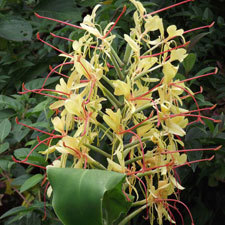 Wild ginger
Wild ginger
Common name: Kahili ginger, ginger lily
Botanical name: Hedychium gardnerianum, Hedychium flavescens
Management programme: Sustained control Rule 5
Wild ginger is native to North India. It is thought to have been brought to New Zealand as an ornamental plant due to its lush foliage and pleasant smelling flowers.
Why is it a pest?
- Wild ginger grows to form extensive dense stands which exclude other vegetation.
- It grows in the shade in native forest and prevents new seedlings establishing.
- Kahili Ginger seeds are spread widely by birds
Where is it found?
- Forests, regenerating forest, streamside forest and gullies.
- Prefers moderate to high fertility, not found in very dry or rocky areas.
- Found mostly in coastal Bay of Plenty and around some of the Rotorua lakes.
What does it look like?
Two species:
Kahili ginger (Hedychium gardnerianum) and
Yellow ginger (Hedychium flavescens).
Roots:
Both species have large bulbous roots that can form a dense layer or mound. Pieces of wild ginger roots can spread in illegally dumped garden rubbish.
Stems and leaves:
Both have stems up to 2m with large shiny leaves.
Flowers:
Kahili ginger produces large pleasant-smelling yellow flowers (summer–autumn) with long red stamens.
Yellow ginger flower clusters are creamy yellow and flower in late autumn.
Fruit:
Kahili ginger – a capsule opens to reveal an orange inside with bright berries that turn brown, hairy, oval and are up to 8cm long.
Yellow ginger does not produce seed.
What are the rules?
Sustained Control
Sustained Control pests are well established in the region and preventing the spread is no longer a realistic objective. Management focuses on reducing general impacts of the pest. Landowners/ occupiers are responsible for the control of these pest species on their land. Council may enforce control.
How do you get rid of it?
- Young seedlings can be pulled out (all year-round) and disposed of in refuse. For larger plants, the stems can be slashed and all of the rhizomes dug out. Place in a black plastic bag and leave to rot down. Do not compost.
- Stump treat – cut larger plants above the pink ‘collar’ at the base and immediately stump paint (November to May) with herbicide on the cut surface.
- Foliar spray with herbicide, ensuring thorough coverage. Spraying is best done when growth is vigorous in late spring, summer and autumn. Thorough spray coverage is important and repeat applications may be necessary.
Tubers can sometimes re-sprout after spraying up to three years later.
Do not plant into sprayed sites for six months.
CAUTION: When using any herbicide or pesticide, PLEASE READ THE LABEL THOROUGHLY to ensure that all instructions and directions for the purchase, use and storage of the product, are followed and adhered to.
Read more on pest control advice, information and regulations
Images







